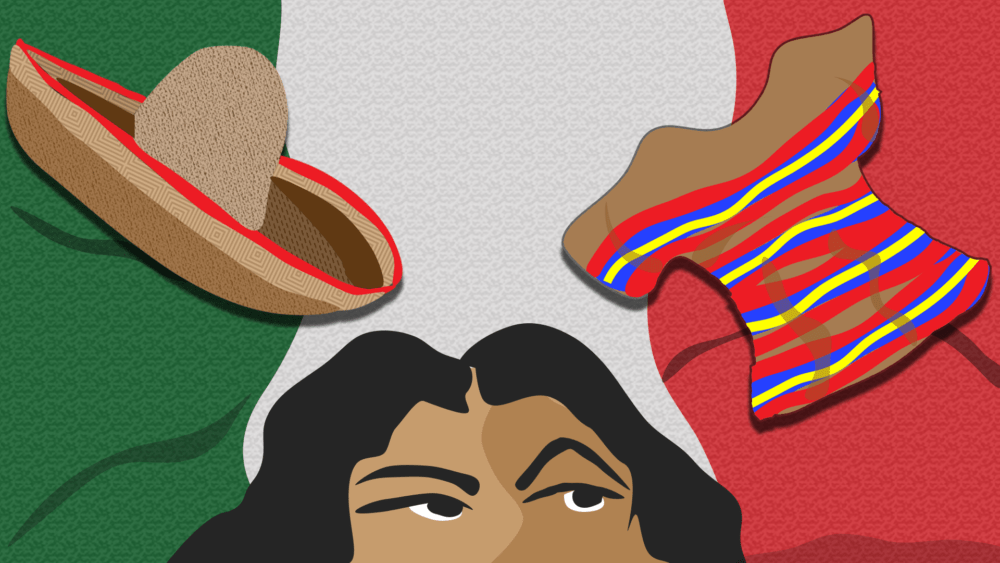Advertisement
Commentary
Please Don't Wear A Sombrero: What Cinco De Mayo Really Means, From A Mexican

A couple of years ago, Danique Montique, a Black student, was walking at the University of New Hampshire when she noticed several white students wearing sombreros and ponchos. It was May 5.
She recorded the students and told them she felt their flippant use of Mexican garb amounted to cultural appropriation. The students Montique confronted became defensive and a shouting match ensued. She uploaded the altercation on social media.
Soon, another social media post mocking Montique, with what appeared to depict blackface was also widely shared. In a matter of days, swastikas appeared on campus, as did a racial epithet targeting African-Americans.
This is how white supremacy works. It always begins with the taking — an entitled grabbing of the cultural symbols of others. A sombrero? A serape? A kimono? Cornrows? They're there for the seizing. And if such snatching is questioned — if we dare confront the audacity by which it plucks what isn't its own — then there is intimidation and terror.
White supremacy grabs and grabs — lands, people, continents, culture — for both power and hollow amusement.
What about the innocuous celebration of cultures outside of your own? Can't well-meaning white folks just have a bowl of guacamole and some beer on Cinco de Mayo without being accused of appropriating? Well, of course.
But I try to avoid celebrations in which people who otherwise do not at all engage with Mexican culture merrily wear sombreros and serapes and chug tequila on this day. I’m not here for that, particularly in a cultural moment when hate crimes against Latinos has increased at least by 24% according to the FBI, we are harassed in public for speaking Spanish and anti-immigrant sentiment is excruciatingly blatant.
My biggest gripe with Cinco de Mayo is not the cultural appropriation, as off-putting as I find it. The real tragedy for me is that a day that once represented Black and brown solidarity — and resistance against colonialism — has been mired by a commercial whitewashing.
Cinco de Mayo commemorates the Battle of Puebla in 1862, when a rag-tag army of mostly indigenous Mexicans defeated French forces who attempted to conquer the independent country. Severely outnumbered and armed with outdated guns, Mexican soldiers defended the city of Puebla, forcing the French to retreat. The French were directed by Emperor Napoleon III, who used debt collecting from Mexico, as a pretext to invade the country.
Napoleon III's efforts were eventually fruitful. A year after the first Battle of Puebla, French forces returned and ushered in a short-lived French occupation of Mexico.
But that first Puebla victory, which delayed the French occupation for a year, appeared to benefit the Union army in a struggle hundreds of miles away: the American Civil War. Some scholars and historians now believe that Napoleon III's invasion of Mexico was a masked attempt to set up a base that could assist the South against the Union. The Union had stopped the flow of cotton to France, forcing French textile manufacturers to lay off workers.
When Napoleon III invaded Mexico, the Civil War, then in its second year, was looking hopeful for the Confederate South and the French emperor had apparently "teased" the South that France would recognize it. Had Mexicans lost the first Battle of Puebla, the French could have assisted the Confederacy when it still had an advantage and the outcome of the Civil War may have been a different one.
At the time, Mexican-Americans in California opposed to slavery felt that the success of the Union could hinge on the Battle of Puebla and upon hearing that Mexican forces had prevailed, they celebrated with fireworks and drinks. Cinco de Mayo was born. (Some of these Mexican-Americans had seen Mexico disavow slavery in 1829 — when California was still part of Mexico — a few years after gaining independence from Spain. Then California joined the Union as a free state in 1850.)
So, Cinco de Mayo began as a Mexican-American holiday, not a Mexican one. In Mexico, it's really only celebrated in Puebla.
In the '60s, Chicano activists in the U.S. revived the holiday, using it as a call to solidarity for Civil Rights.
But by 1989, beer companies usurped the day, using it as a commercial opportunity to increase their revenues and began to market the day for white audiences, too. Now, it's mostly an excuse for college frats to get drunk and appropriate our culture without really thinking about Mexicans. It's also one of the most profitable days outside of Christmas holidays for booze companies.
But I know what Cinco de Mayo is to me. It was one of the first holidays enacted by people who didn't divide loyalties based on borders. Instead, they stood in solidarity with people different from them. They understood that none of us are free until we are all free.
When I think of the forces at work in 1862 — colonialism, a fight to continue to own people as property because of the color of their skin, oppression and imperialism disguised as economic policy — it seems to me that I can almost trace that entitlement to the events at the University of New Hampshire and any number of racist incidents happening today. The same malevolent force stands behind all hate. Then and now.
And it seeks to take what it doesn't have.
If you don't know or care what Cinco de Mayo really celebrates, if you haven't spent some time thinking about your own biases against Mexicans, if you don't know the history of lynchings and systemic discrimination against Mexicans in this country, if you avoid conversations about immigration or enter them in bad faith, if you don't know the human cost it took for Mexicans to change some fundamental labor laws in this country, or if you don't have any Mexican friends in your life, maybe you shouldn't celebrate Cinco de Mayo.
No matter what, avoid the sombrero. It's not yours to take.
